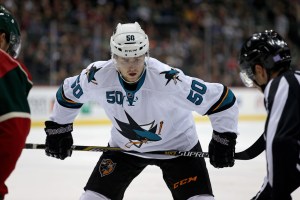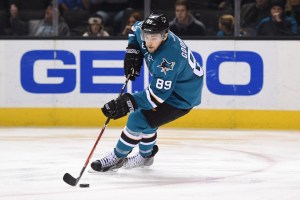The Coaching Search
The Sharks search for a new head coach continues, but it is worth noting the choice made by the Flyers. The Flyers took the path less traveled and hired a very successful college coach. The ability to develop young players is essential to being a successful college coach. The ability to develop young players is exactly what the Sharks publicly-stated road map requires. While the usual suspects are reportedly being interviewed (Peter DeBoer, Adam Oates, Randy Carlyle, etc.) management should also consider going off the board. At least one name has been rumored, Boston University’s Dave Quinn.
Smaller, Larger, Better?

The Sharks have gotten smaller upfront. In the last 12 months, the Sharks have seen the following every day players depart from their forward lines: Brent Burns 6’5”. Andrew Desjardins 6’1”. James Sheppard 6’1”. Part-timer Tye McGinn 6’3” is also gone and it is likely the Sharks will not retain another part-time player in John Scott 6’8”.
Replacements include Melker Karlsson and Chris Tierney, both 6’0”. At this point, the tallest forwards are Joe Thornton and Patrick Marleau, at 6’4” and 6’2” respectively. Tomas Hertl, Logan Couture and Barclay Goodrow are the only other forwards 6’1” or larger.
There are 9 forwards on the current roster that are 6’0” or under: Karlsson, Tierney, Mike Brown, Matt Nieto, Ben Smith, Joe Pavelski, Raffi Torres, Tommy Wingels and Daniil Tarasov. The top forward prospect and last years top pick is Nikolay Goldobin, is 6’0”. The Sharks currently project to have 7-8 forwards at 6’0” or under in the line-up on a regular basis. Two years ago today, on May 26, 2013, the Sharks had 8 forwards 6’1” or larger in their round 2 (game 6) win over the Kings.
Size doesn’t always translate to physical play. Still, Desjardins, Scott and Sheppard were 4th, 5th and 6th respectively for hits among Sharks forwards, even though none played more than 57 games in teal this past season. Aggressive and physical forechecking couples nicely with a puck-possession playing style. This is the style the Sharks have used for several years. It will be interesting to see if the Sharks indeed wind up with a smaller, less physical forward group. If that happens, it will be interesting to see the impact it has on their style of play.
Also worth noting, the Sharks have gotten considerably bigger on the blue line. Brent Burns, Brenden Dillon and Mirco Mueller all replaced smaller defensemen, they are now the 3 tallest defensemen on the team. The Sharks used 11 defensemen last season. In terms of +/-, those 3 taller defensemen were the worst on the team, finishing 9th, 10th and 11th. Bigger wasn’t better on the blue line.
The Minors

The Washington Capitals minor league team from Hershey played the San Jose Sharks minor league team from Worcester in the AHL playoffs. With San Jose missing the NHL playoffs, Worcester was able to tap into the San Jose roster, adding 2 of San Jose’s ‘everyday’ players: Chris Tierney and Barclay Goodrow. The Capitals, as they were playing in the postseason, did not provide the same upgrade to their farm team. In essence, Worcester had 2 of San Jose’s top 12 forwards on their roster, while Hershey had none of the Caps top 14 forwards on their roster. In total, Worcester’s playoff roster had players that had played a combined 159 games for San Jose this season. The comparable number for Hershey was 67. Hershey won the series in 4 games (best of 5), including a 10-4(!) thumping in the series finale. For a team counting heavily on their prospects for the near term future, the Sharks had hoped for better.
 Brent Burns
Brent Burns
Brent Burns was voted top defensemen in the World Championships. It still doesn’t say anything about his ability to play defense in the NHL.
Salary Cap
The salary cap forecast for next year is $71million, a modest increase of about $2million over the current season. This is down from the $73million forecast made last November. For a team in a rebuilding mode like the Sharks, the smaller the cap is, the better. There are several teams that will be squeezed to get under the cap, which will means some pretty good players should be available via trade. Owner Hasso Plattner spoke about this approach in his recent remarks. General Manager Doug Wilson’s preferred method for player acquisition has been through trades, as opposed to free agency. The salary cap figure is typically announced near the end of June. Where it lands can either help or complicate the Sharks offseason plans. The reduced forecast appears to be good news for the Sharks.